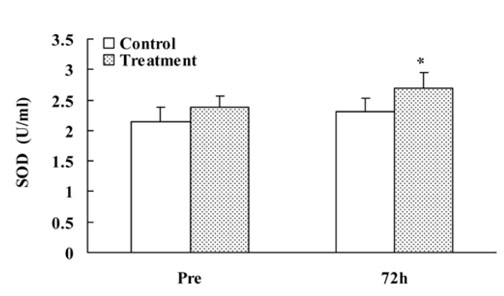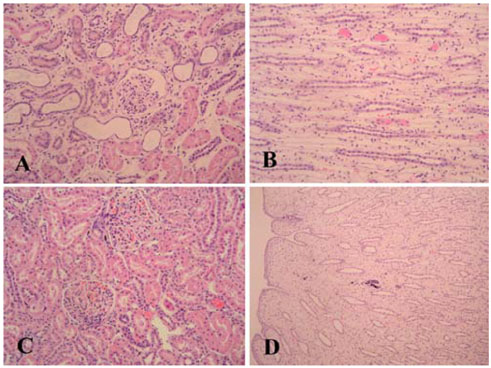J Vet Sci.
2006 Dec;7(4):375-379. 10.4142/jvs.2006.7.4.375.
Attenuation of ischemia-reperfusion injury by ascorbic acid in the canine renal transplantation
- Affiliations
-
- 1Laboratory of Veterinary Surgery, College of Veterinary Medicine, Chungnam National University, Daejeon 305-764, Korea. dalbi77@hanmail.net, jaeil@snuh.org
- 2Laboratory of Veterinary Pathology, College of Veterinary Medicine, Chungnam National University, Daejeon 305-764, Korea.
- KMID: 1089486
- DOI: http://doi.org/10.4142/jvs.2006.7.4.375
Abstract
- This study examined the effects of ascorbic acid on the attenuation of an ischemia-reperfusion (I/R) injury after a canine renal transplantation. Eight beagle dogs were subjected to a renal auto-transplantation followed by the administration of ascorbic acid (treatment group) and the same amount of vehicle (physiological saline, control group). Blood samples were collected from these dogs to perform the kidney function tests and the invasive blood pressure was measured in the renal artery at pre- and post-anastomosis. The antioxidant enzymes of level 72 h after the transplant were measured. The kidneys were taken for a histopathology evaluation at day 21. The kidney function tests showed a significant difference between the control and treatment group. The invasive blood pressure in the renal artery was similar in the groups. The activity of the antioxidant enzymes in the blood plasma was significant lower in the control group than in the treatment group. The histopathology findings revealed the treatment group to have less damage than the control group. The results of this study suggest that ascorbic acid alone might play a role in attenuating I/R injury and assist in the recovery of the renal function in a renal transplantation model.
Keyword
MeSH Terms
-
Animals
Ascorbic Acid/*therapeutic use
Blood Pressure
Blood Urea Nitrogen
Catalase/blood
Creatinine/blood
Dog Diseases/blood/*drug therapy/pathology
Dogs/*surgery
Female
Free Radical Scavengers/therapeutic use
Glutathione Peroxidase/blood
Histocytochemistry/veterinary
Kidney Transplantation/pathology/*veterinary
Male
Random Allocation
Reperfusion Injury/blood/drug therapy/pathology/*veterinary
Superoxide Dismutase/blood
Figure
Reference
-
1. Andreoli SP. Reactive oxygen molecules, oxidant injury and renal disease. Pediatr Nephrol. 1991. 5:733–742.
Article2. Barnard ML, Snyder SJ, Engerson TD, Turrens JF. Antioxidant enzyme status of ischemic and postischemic liver and ischemic kidney in rats. Free Radic Biol Med. 1993. 15:227–232.
Article3. Bosco PJ, Schweizer RT. Use of oxygen radical scavengers on autografted pig kidneys after warm ischemia and 48-hour perfusion preservation. Arch Surg. 1988. 123:601–604.
Article4. Casanova D, Correas M, Moran JL, Salas E, Amado JA, Garcia Unzueta MT, Berrazueta JR. Nitric oxide in cold and warm ischemia reperfusion renal transplantation. Transplant Proc. 2002. 34:45–46.
Article5. Chade AR, Rodriguez-Porcel M, Herrmann J, Krier JD, Zhu X, Lerman A, Lerman LO. Beneficial effects of antioxidant vitamins on the stenotic kidney. Hypertension. 2003. 42:605–612.
Article6. Cristol JP, Thiemermann C, Mitchell JA, Walder C, Vane JR. Support of renal blood flow after ischaemic-reperfusion injury by endogenous formation of nitric oxide and of cyclo-oxygenase vasodilator metabolites. Br J Pharmacol. 1993. 109:188–194.
Article7. Dobashi K, Ghosh B, Orak JK, Singh I, Singh AK. Kidney ischemia-reperfusion: modulation of antioxidant defenses. Mol Cell Biochem. 2000. 205:1–11.8. Gianello P, Saliez A, Bufkens X, Pettinger R, Misseleyn D, Hori S, Malfroy B. EUK-134, a synthetic superoxide dismutase and catalase mimetic, protects rat kidneys from ischemia-reperfusion-induced damage. Transplantation. 1996. 62:1664–1666.
Article9. Hariharan S, Johnson CP, Bresnahan BA, Taranto SE, McIntosh MJ, Stablein D. Improved graft survival after renal transplantation in the United States, 1988 to 1996. N Engl J Med. 2000. 342:605–612.
Article10. Hearse DJ, Bolli R. Reperfusion induced injury: manifestations, mechanisms, and clinical relevance. Cardiovasc Res. 1992. 26:101–108.
Article11. Iheanacho EN, Stocker R, Hunt NH. Redox metabolism of vitamin C in blood of normal and malaria-infected mice. Biochim Biophys Acta. 1993. 1182:15–21.
Article12. Lee JI, Kim MJ, Park CS, Kim MC. Influence of ascorbic acid on BUN, creatinine, resitive index in canine renal ischemia-reperfusion injury. J Vet Sci. 2006. 7:79–81.
Article13. Mathews KG, Gregory CR. Renal transplants in cats: 66 cases (1987-1996). J Am Vet Med Assoc. 1997. 211:1432–1436.14. Kanani PM, Sinkey CA, Browning RL, Allaman M, Knapp HR, Haynes WG. Role of oxidant stress in endothelial dysfunction produced by experimental hyperhomocyst(e)inemia in humans. Circulation. 1999. 100:1161–1168.
Article15. Mihara M, Uchiyama M. Determination of malonaldehyde precursor in tissues by thiobarbituric acid test. Anal Biochem. 1978. 86:271–278.
Article16. Miyata T, Kurokawa K, van Ypersele de Strihou C. Relevance of oxidative and carbonyl stress to long-term uremic complications. Kidney Int Suppl. 2000. 76:S120–S125.
Article17. Mun KC, Bae JH, Suh SI, Kim YH, Lee SH, Kim SP, Kwon TK, Hwang JS. Effect of modified polyhemoglobin on the oxidative damage after ischemia-reperfusion in the liver. Transplant Proc. 2003. 35:126–127.
Article18. Pollak R, Prusak BF, Mozes MF. Anatomic abnormalities of cadaver kidneys procured for purposes of transplantation. Am Surg. 1986. 52:233–235.19. Rubowitz A, Assia EI, Rosner M, Topaz M. Antioxidant protection against corneal damage by free radicals during phacoemulsification. Invest Ophthalmol Vis Sci. 2003. 44:1866–1870.
Article20. Sarin PK, Dhanda R, Siwach V, Aggarwal B, Singh B, Kaur R, Jain PK. Bridging of renal arteries: a simple technique for the management of double arteries in living donor renal allograft transplantation. Transplant Proc. 2003. 35:35–36.
Article21. Sekhon CS, Sekhon BK, Singh I, Orak JK, Singh AK. Attenuation of renal ischemia/reperfusion injury by a triple drug combination therapy. J Nephrol. 2003. 16:63–74.22. Sies H. Oxidative stress: oxidants and antioxidants. Exp Physiol. 1997. 82:291–295.
Article23. Suzuki K, Ushiyama T, Ishikawa A, Mugiya S, Fujita K. Retroperitoneoscopy assisted live donor nephrectomy: the initial 2 cases. J Urol. 1997. 158:1353–1356.
Article24. Takada M, Nadeau KC, Shaw GD, Marquette KA, Tilney NL. The cytokine-adhesion molecule cascade in ischemia/reperfusion injury of the rat kidney. Inhibition by a soluble P-selectin ligand. J Clin Invest. 1997. 99:2682–2690.
Article25. Tietze F. Enzymic method for quantitative determination of nanogram amounts of total and oxidized glutathione: applications to mammalian blood and other tissues. Anal Biochem. 1969. 27:502–522.
Article26. Timimi FK, Ting HH, Haley EA, Roddy MA, Ganz P, Creager MA. Vitamin C improves endothelium-dependent vasodilation in patients with insulin-dependent diabetes mellitus. J Am Coll Cardiol. 1998. 31:552–557.
Article27. Ting HH, Timimi FK, Haley EA, Roddy MA, Ganz P, Creager MA. Vitamin C improves endothelium-dependent vasodilation in forearm resistance vessels of humans with hypercholesterolemia. Circulation. 1997. 95:2617–2622.
Article28. Vedder NB, Winn RK, Rice CL, Chi EY, Arfors KE, Harlan JM. Inhibition of leukocyte adherence by anti-CD18 monoclonal antibody attenuates reperfusion injury in the rabbit ear. Proc Natl Acad Sci USA. 1990. 87:2643–2646.
Article29. Vita JA, Frei B, Holbrook M, Gokce N, Leaf C, Keaney JF Jr. L-2-Oxothiazolidine-4-carboxylic acid reverses endothelial dysfunction in patients with coronary artery disease. J Clin Invest. 1998. 101:1408–1414.
Article
- Full Text Links
- Actions
-
Cited
- CITED
-
- Close
- Share
- Similar articles
-
- Influence of ascorbic acid on BUN, creatinine, resistive index in canine renal ischemia-reperfusion injury
- Kidney transplantation and ischemic conditioning: past, present and future perspectives
- Hepatic ischemia-reperfusion injury with respect to oxidative stress and inflammatory response: a narrative review
- The Effects of Prostacyclin on PaO2, Pulmonary Vascular Resistance and Pulmonary Water Content in the Experimental Canine Undergoing Pulmonary Ischemia-Reperfusion Injury
- Ethyl Pyruvate Ameliorates Renal Ischemia- reperfusion Injury





